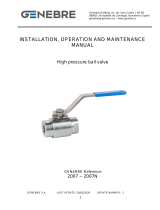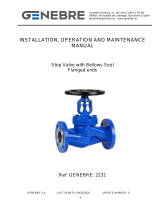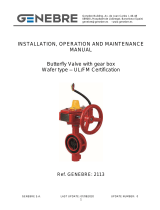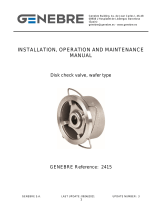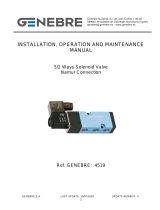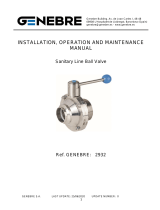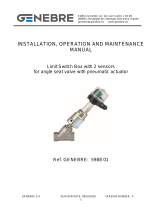Page is loading ...

Genebre Building. Av. de Joan Carles I, 46-48
08908 L'Hospitalet de Llobregat. Barcelona (Spain)
[email protected] - www.genebre.es
GENEBRE S.A.
LAST UPDATE: 23/03/2020 UPDATE NUMBER: 1
1
INSTALLATION, OPERATION AND MAINTENANCE
MANUAL
Static Balancing Valve
Flanged Ends
Ref. GENEBRE: 2228

Genebre Building. Av. de Joan Carles I, 46-48
08908 L'Hospitalet de Llobregat. Barcelona (Spain)
[email protected] - www.genebre.es
GENEBRE S.A.
LAST UPDATE: 23/03/2020 UPDATE NUMBER: 1
2
Installation, operation and maintenance instructions
1. Product description ............................................................................... 3
2. Transport and Storage conditions ....................................................... 3
3. Exploded drawing ................................................................................. 4
4. Installation instructions …….............................................................. 5
4.1 Preparation ………………….................................................................. 5
4.2 Installation of valves with flanged ends ……..……………………... 6
4.3 Calculation of flow and adjustment of the handwheel ………………... 7
5. Operating instructions
5.1 Usage .................................................................................................... 7
5.2 Manual operation .................................................................................. 7
6. Maintenance instructions ...................................................................... 8
7. Reparation instructions ....................................................................... 8
8. Flowcharts ............................................................................................. 9
9. Hygiene and Safety Instructions ........................................................... 14

Genebre Building. Av. de Joan Carles I, 46-48
08908 L'Hospitalet de Llobregat. Barcelona (Spain)
[email protected] - www.genebre.es
GENEBRE S.A.
LAST UPDATE: 23/03/2020 UPDATE NUMBER: 1
3
1. Product description.
Genebre, S.A. offers a wide range of valves designed and assembled to handwheel and
drive fluids in industrial procedures.
The compatibility of materials used to build the valves (see corresponding Data Sheet)
and the application of valves to the different industrial processes is at user's risk. Valves
will have an optimal behavior when working conditions do not exceed pressure and
temperature limits (pressure curve) for which they have been designed.
Balancing valves with flanged ends are used when it is needed to precisely regulate the
flow in large heating and cooling circuits.
2. Transport and Storage conditions
Transport and storage of this kind of products must be done keeping them in their
original package!
VISUAL INSPECTION
Check whether during transport, unloading and placement the products have suffered
damages.
During storage it is recommended to keep them into the included protective wrapping to
avoid damages or dirt accumulation in the inside part of the valve.The wrap must not be
removed until valve is to be installed.
Valves must be stored in a dry and clean environment.
If you notice any kind of anomaly during reception of the goods, contact immediately
with GENEBRE in order to determine the possible responsibilities on the issue.
IMPORTANT NOTE:
Before installing and/or manipulating these elements, READ CAREFULLY these
instructions for use and OBSERVE all contained information. If you fail to
understand any of their content, please contact GENEBRE, S.A.

Genebre Building. Av. de Joan Carles I, 46-48
08908 L'Hospitalet de Llobregat. Barcelona (Spain)
[email protected] - www.genebre.es
GENEBRE S.A.
LAST UPDATE: 23/03/2020 UPDATE NUMBER: 1
4
User is responsible for the safe use of these products, according to present
instructions for use and specific technical documentation of the device.
3. Exploded drawing

Genebre Building. Av. de Joan Carles I, 46-48
08908 L'Hospitalet de Llobregat. Barcelona (Spain)
[email protected] - www.genebre.es
GENEBRE S.A.
LAST UPDATE: 23/03/2020 UPDATE NUMBER: 1
5
Nº
Name
Material
Surface Treatment
Spare Part Code
1
Body
EN-GJS-450
Painted
-----
2
Disc
ASTM A126 B + EPDM
------
-----
3
Stem Nut
Cooper Alloy
------
-----
4
Disc Cover
Latón / Brass
------
-----
5
Stem
ASTM A276 420
------
-----
6
Bonnet
EN-GJS-450
Painted
-----
7
Bolt
Carbon Steel
Painted
-----
8
O-ring
EPDM
------
-----
9
O-ring
EPDM
------
-----
10
Gland Flange
ASTM A536 65-45-12
Ni plated
-----
11
Link Cover
ABS
------
-----
12
Direction Cover
ABS
------
-----
13
Scale Ring
Black Plastic
------
-----
14*
Handwheel
≤ 6” Aluminium / ≥ 8” Steel
Painted
V2228 xx
15
Cover
Polietileno / PE
------
-----
16
Screw
ASTM A276 420
------
-----
17
Washer
ASTM A276 420
------
-----
18
Locating Screw
AISI 1035
Zn plated
-----
19
Screw
Carbon Steel
Zn plated
-----
20
Screw
ASTM A276 420
------
-----
21
Gasket
EPDM
------
-----
22*
/ Test Point
Brass
------
T2228 xx
* Available spare parts
4. Installation instructions
4.1) Preparation
Remove any material remains of the valve wrapping.
Serious problems may arise with the installation of a valve in a dirty pipe.
Make sure the pipe is not dirty and doesn’t have welding particles, for example, before
installing it. This may cause irreparable damages in the valve when the equipment is
started → prepare a clean working area.
Plan beforehand enough space for future maintenance operations.
Control the correct performance of the valve by turning the handwheel both sides (close
and open) and observing if the disc or needle slides correctly. If this is not the case,
check if there are foreign particles inside the valve and repeat the whole operation.

Genebre Building. Av. de Joan Carles I, 46-48
08908 L'Hospitalet de Llobregat. Barcelona (Spain)
[email protected] - www.genebre.es
GENEBRE S.A.
LAST UPDATE: 23/03/2020 UPDATE NUMBER: 1
6
4.2) Installation of valves with flanged ends
Design for this kind of regulation valves allows only one position for
assembling it to the pipe, specified by means of an arrow in the valve's body
that indicates the direction in which the fluid needs to circulate.
Do not disassemble the valves to install them.
Make sure the pipe's and edges flanges of the valve are clean.
Use the corresponding screws in all of the flanges drill holes.
Place an adequate joint in each end and align it in the centre of the flanges.
Tighten screws evenly and cross-shaped to avoid deformations. To do so, you must not
force in any case the pipe to centre the valve; it should take its position smoothly. Last,
verify that screws are tightened with the recommended torque for each type of screw.
Make sure the flanges joints are well placed.
After assembling, check the tightness and performance of the valve.
It is recommended to install the valve in horizontal position and the handwheel
upwards. A valve installed vertically could distort the results in flow measurement.
A valve installed with the handwheel downwards might produce leakage by dirt
accumulation on the seat.
ATTENTION:
- install expansion joints in the pipe line.
- valves do not have to support pipe's efforts so it is advisable to anticipate a good
alignment and parallelism of such pipe.
- it is also recommended to use filters in the pipe to extend lifecycle of the valve.
- The valve should not be mounted adjacent to one elbow, reducer, valve or pump,
to avoid turbulence. The minimum recommended distance between these elements

Genebre Building. Av. de Joan Carles I, 46-48
08908 L'Hospitalet de Llobregat. Barcelona (Spain)
[email protected] - www.genebre.es
GENEBRE S.A.
LAST UPDATE: 23/03/2020 UPDATE NUMBER: 1
7
is 10 times the diameter of the pipe upstream and 3 times the diameter of the pipe
downstream, according to CR 13932: 2000. If this recommendation is omitted, the
influence of turbulence on the flow rate could reach 20%.
4.3) Calculation of flow and adjustment of the handwheel
Measuring the differential of pressure between the two checkpoints and placing the
handwheel in a given position can be determined the circulating flow through the valve.
To this we must use the included diagrams and tables in paragraph 8 together with two
gauges, or by using a special flow meter.
Once the handwheel is in the desired position, lock it by using the "preset screw" inside
the handwheel. It will be necessary to remove the red Cover (part. 15) and turn clockwise
the Locating Screw (part. 18) by using Allen key until it stops.
NOTE: The flow diagrams of Section 8 are based on the calculation with pure water. For
use with water + glycol, whose density is higher, the following correction factor should be
applied according to the proportion of antifreeze:
0.96 (25% glycol) / 0.92 (50% glycol) / 0.89 (75% glycol) / 0.86 (100% glycol)
5. Operating instructions
5.1) Usage
GENEBRE valves provide good sealing when used adjusted to the pressure and
temperature values for which they have been designed.
Valve materials have to be fully compatible with the fluid circulating through the valve.
Otherwise, valve could be seriously damaged.
Do not use for slurries or fluids containing solids that can build up in valve
cavities.
5.2) Manual operation
In general, once the valve is installed, it should not be operated unless a maintenance
operation to be performed.
To close, the operation consists in turning the handwheel clockwise and anticlockwise if
you want to open the valve.

Genebre Building. Av. de Joan Carles I, 46-48
08908 L'Hospitalet de Llobregat. Barcelona (Spain)
[email protected] - www.genebre.es
GENEBRE S.A.
LAST UPDATE: 23/03/2020 UPDATE NUMBER: 1
8
6. Maintenance instructions
Frequency, place and process of maintenance will be determined by the user by taking
into account usage of the product. However, periodical checks explained below will be
useful to extend the service life of the valve and reduce installation problems.
6.1) Valves must not remain in open or closed position for a long period of time. It is
recommended, if the process allows for it, to operate it for control purposes every six
months.
6.2) Verify possible leaks through the line (due to closure); this defect is probably caused
by deposition of impurities between the disc or needle and the seat, transported by the
fluid. Disassemble the valve from the pipe, clean it thoroughly and reinstall it. If the
problem persists you should change the valve. Probably the elastomer closure has been
damaged by the use (see Section 7).
7. Reparation instructions
These types of valves, due to their assembling specifications are not worth repairing,
because most of the times are simply not cost-effective, so we recommend to directly
replace them.
Before disassembling the pipe's valve to clean or replace it, make sure that line
has been closed and depressurized because a bad operational procedure could
cause a serious accident to staff and installation system
Before installing new valve, check if it meets the requirements of the valve
being replaced

Genebre Building. Av. de Joan Carles I, 46-48
08908 L'Hospitalet de Llobregat. Barcelona (Spain)
[email protected] - www.genebre.es
GENEBRE S.A.
LAST UPDATE: 23/03/2020 UPDATE NUMBER: 1
9
8. Flowcharts
Handwheel
Position
Kv (m3/h @ 1 bar)
50 65 80 100 125 150 200 250 300
1
6.9
14.5
18.5
37.2
64.3
89.6
87.3
113.4
163.4
2
12.2
27.5
32.7
69.4
104.4
146.3
160.6
173.5
295.3
3
18.3
40.5
50.8
102.5
150.5
213.4
240.5
241.8
455.5
4
25.5
53.2
71.8
133.5
196.7
275.6
331.4
318.5
643.5
5
33.9
64.4
89.7
163.4
241.5
338.4
420.3
413.4
852.4
6
40.2
73.4
107.3
189.6
280.4
404.5
498.5
523.5
1037.6
7
44.4
81.6
118.8
213.5
309.5
448.6
573.6
630.6
1197.8
8
47.3
86.6
131.2
230.4
331.3
478.2
641.4
727.8
1384.8
9
----
----
----
----
----
----
704.6
819.6
1568.1
10
----
----
----
----
----
----
764.5
918.1
1739.0
11
----
----
----
----
----
----
811.9
1018.2
1919.4
12
----
----
----
----
----
----
865.6
1116.3
2099.4
* flow rate within the following tolerances: ±18% (at the 25% open position) and ±10% (at the fully
open position), according to BS 7350 standard.
10
100
1000
10000
0,10 1,00 10,00 100,00 1.000,00
mbar
Q (caudal m3/h)
DIAGRAMA DE FLUJO / FLOW DIAGRAM
VÁLVULA DN 50 / DN 50 VALVE
1
2
3
4
5
6
7
8
Posición de volante / Handwheel Position

Genebre Building. Av. de Joan Carles I, 46-48
08908 L'Hospitalet de Llobregat. Barcelona (Spain)
[email protected] - www.genebre.es
GENEBRE S.A.
LAST UPDATE: 23/03/2020 UPDATE NUMBER: 1
10
10
100
1000
10000
0,10 1,00 10,00 100,00 1.000,00
mbar
Q (caudal m3/h)
DIAGRAMA DE FLUJO / FLOW DIAGRAM
VÁLVULA DN 65 / DN 65 VALVE
1
2
3
4
5
6
7
8
Posición de volante / Handwheel Position
10
100
1000
10000
0,10 1,00 10,00 100,00 1.000,00
mbar
Q (caudal m3/h)
DIAGRAMA DE FLUJO / FLOW DIAGRAM
VÁLVULA DN 80 / DN 80 VALVE
1
2
3
4
5
6
7
8
Posición de volante / Handwheel Position

Genebre Building. Av. de Joan Carles I, 46-48
08908 L'Hospitalet de Llobregat. Barcelona (Spain)
[email protected] - www.genebre.es
GENEBRE S.A.
LAST UPDATE: 23/03/2020 UPDATE NUMBER: 1
11
10
100
1000
10000
1,00 10,00 100,00 1.000,00
mbar
Q (caudal m3/h)
DIAGRAMA DE FLUJO / FLOW DIAGRAM
VÁLVULA DN 100 / DN 100 VALVE
1
2
3
4
5
6
7
8
Posición de volante / Handwheel Position
10
100
1000
10000
1,00 10,00 100,00 1.000,00 10.000,00
mbar
Q (caudal m3/h)
DIAGRAMA DE FLUJO / FLOW DIAGRAM
VÁLVULA DN 125 / DN 125 VALVE
1
2
3
4
5
6
7
8
Posición de volante / Handwheel Position

Genebre Building. Av. de Joan Carles I, 46-48
08908 L'Hospitalet de Llobregat. Barcelona (Spain)
[email protected] - www.genebre.es
GENEBRE S.A.
LAST UPDATE: 23/03/2020 UPDATE NUMBER: 1
12
10
100
1000
10000
1,00 10,00 100,00 1.000,00 10.000,00
mbar
Q (caudal m3/h)
DIAGRAMA DE FLUJO / FLOW DIAGRAM
VÁLVULA DN 150 / DN 150 VALVE
1
2
3
4
5
6
7
8
Posición de volante / Handwheel Position
10
100
1000
10000
1,00 10,00 100,00 1.000,00 10.000,00
mbar
Q (caudal m3/h)
DIAGRAMA DE FLUJO / FLOW DIAGRAM
VÁLVULA DN 200 / DN 200 VALVE
1
2
3
4
5
6
7
8
9
10
11
12
Posición de volante / Handwheel Position

Genebre Building. Av. de Joan Carles I, 46-48
08908 L'Hospitalet de Llobregat. Barcelona (Spain)
[email protected] - www.genebre.es
GENEBRE S.A.
LAST UPDATE: 23/03/2020 UPDATE NUMBER: 1
13
10
100
1000
10000
1,00 10,00 100,00 1.000,00 10.000,00
mbar
Q (caudal m3/h)
DIAGRAMA DE FLUJO / FLOW DIAGRAM
VÁLVULA DN 250 / DN 250 VALVE
1
2
3
4
5
6
7
8
9
10
11
12
Posición de volante / Handwheel Position
10
100
1000
10000
1,00 10,00 100,00 1.000,00 10.000,00
mbar
Q (caudal m3/h)
DIAGRAMA DE FLUJO / FLOW DIAGRAM
VÁLVULA DN 300 / DN 300 VALVE
1
2
3
4
5
6
7
8
9
10
11
12
Posición de volante / Handwheel Position

Genebre Building. Av. de Joan Carles I, 46-48
08908 L'Hospitalet de Llobregat. Barcelona (Spain)
[email protected] - www.genebre.es
GENEBRE S.A.
LAST UPDATE: 23/03/2020 UPDATE NUMBER: 1
14
9. Hygiene and Safety Instructions
9.1) Fluid passing through a valve or accessory can be corrosive, toxic, flammable or
pollutant. When operating valves, you must follow the security instructions and it is
recommended to use personal protection gadgets:
1) Protect your eyes.
2) Wear gloves and appropriate working clothes.
3) Wear safety footwear.
4) Wear a helmet.
5) Have running water at hand.
6) To operate flammable fluids, make sure you have an extinguisher at hand.
9.2) Before removing a valve from a pipe, check always if the line is completely
drained and depressurized.
9.3) Operate the valve in open position to make sure there is no pressure in the internal
cavity.
9.4) Any valve being used by toxic services department needs to obtain a cleanliness
certificate before being operated.
/
